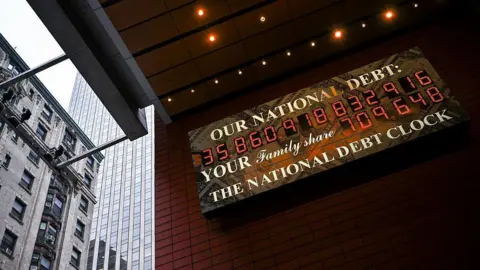US debt downgrade drives up borrowing costs
 AFP/Getty
AFP/GettyInvestors might have hoped the turmoil that hit financial markets last month was over. But another bout of volatility in US borrowing costs is a sign that worries continue to bubble.
The interest rate on the US government's long-term debt surpassed the 5% on Monday, before retreating slightly. That was the highest level since October 2023.
It came after Moody's downgraded the US government's credit rating on Friday, citing the rising debt over the past decade.
Congress is meanwhile advancing a tax-and-spending bill that would add trillions to the US government's $36tn in debt.
What is a government bond?
When a government wants to borrow money, it usually does so by selling bonds - sometimes called Treasuries - to investors on financial markets.
Investors buy the bond, providing the government with cash, and are typically repaid, plus interest over a number of pre-agreed years.
Just as with a regular loan, bonds perceived to be risky have higher interest rates, also called yields.
Investors who buy bonds are mainly made up of financial institutions, ranging from pension funds to central banks such as the Bank of England.
Some hold on to the bonds until the term of the loan expires, while others sell them to other investors.
What's happening with US bonds?
Historically, the US government has been shielded from having to pay high interest rates, because Treasuries have been considered safe.
That is because the US economy has been strong, with stable prices, and the US government was considered a reliable partner, unlikely to default.
The yields on 30-year Treasuries hovered around 3% for much of decade following the 2008 financial crisis.
When it crossed 5% in October 2023, it was the first time it had hit that threshold in 16 years.
The yield on 30-year Treasuries climbed to 5.04% on Monday, up from 4.9% on Friday before the downgrade, before falling back under the 5% mark.
So what are the new risks?
Yields started rising in 2021, as the US was hit by soaring prices after the Covid-19 pandemic.
Concerns reignited last month, after President Donald Trump's imposition of tariffs globally, which analysts said would hurt the economy and drive up prices.
At the same time, the US has been running up its debt, with little sign of slowdown in sight.
On Friday, Moody's downgraded the US government's credit rating, citing the growing debt and little progress toward resolving it.
The move was not unexpected. Moody's was the last of the three rating agencies to take the step and had warned in 2023 that this might happen.
But the situation it described was underscored when part of Congress voted on Sunday to advance a tax bill that would add at least $3tn to US debt over the next decade.
The "Moody's downgrade is, effectively, a political assessment, as much as it is an economic one", wrote Macquarie Bank analyst Thierry Wizman.
"The political and institutional breakdown - in regard to the US's lack of capacity to 'course correct', is the true meaning of the downgrade, rather than the high debt load itself."
How does this affect ordinary Americans?
According to Moody's, interest payments in the US are on a path to consume 30% of the federal government's revenue by 2035, compared with 9% in 2021.
If the US government is spending more on debt interest repayments, it can affect budgets and public spending as it becomes more costly for the government to sustain itself.
Just as importantly, interest rates for the government typically influence interest rates charged on other kinds of loans, such as mortgages or credit cards.
So higher interest rates for the government mean higher interest rates for households and businesses, too.
Businesses, especially small ones, are likely to be hardest hit by any immediate change in borrowing rates, as most homeowners in the US have fixed-rate deals of between 15 and 30 years.
If businesses can't get access to credit, that can halt economic growth and lead to job losses over time.
First-time buyers and those wishing to move home could also face higher costs.
